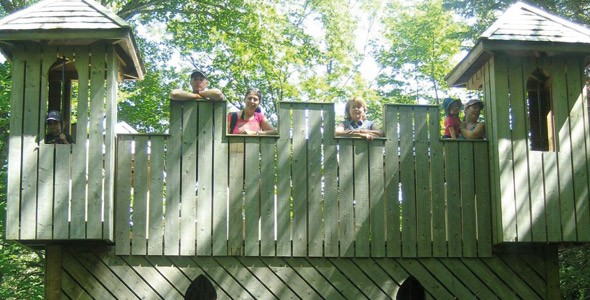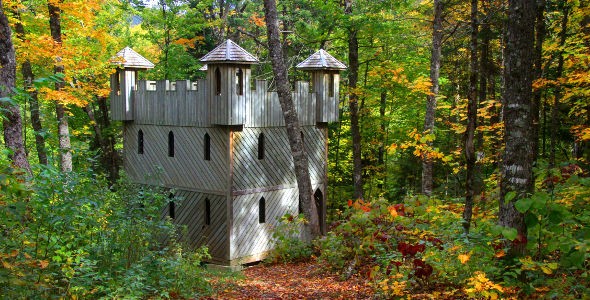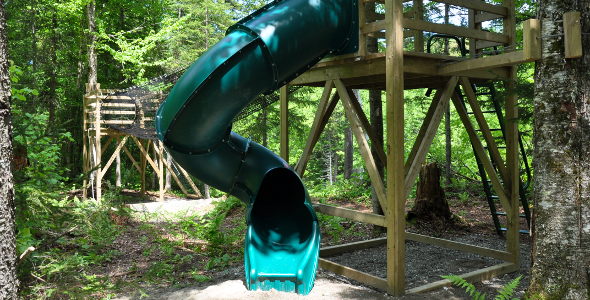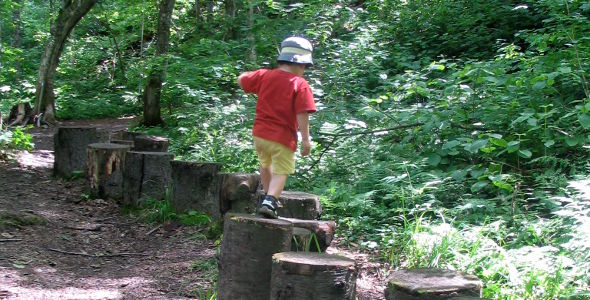Home » Activities » Rope course
Located near the park’s visitor center, the rope course offers 15 different challenges for the whole family. Here are just a few:
Rope bridge
UPDATE, SEPTEMBER 5TH 2020: THE ROPE BRIDGE IS OPEN AGAIN.
Practice your balance, and your composure, as you cross over the river on this swingy rope bridge.
Never-ending tunnel
Watch out or you might stay stuck in the never-ending tunnel of net…just like the fly gets stuck in a spider web!
Labyrinth Castle
Finding your way to the top of the castle might not be as easy as you thought it would be! Take a wrong turn and you might be looking for the way out forever!
Rock climbing wall
This elephant of a rock is not easy to mount! Whatever happens, don’t let go!
A lot more fun awaits you on the course. Come take up the challenge with your whole family!
SAFETY GUIDELINES AND USEFUL TIPS FOR THE ROPE COURSE
BEFORE YOU LEAVE
- You must register at the visitor center before going on the course
- The rope course is for children over 5 years old, unless it is specified differently on the obstacle. All children under the age of 16 must be accompanied by an adult
- Make sure you read and understand the potential risks associated (a list is available at the visitor center)
- Choose synthetic clothing rather than cotton, they will dry faster and keep you warm even if they are wet
- Bring enough water (1 litre minimum) and a snack
- Bring a small backpack with a headlamp, matches, sunscreen lotion, a first aid kit and a trail map
- Plan your itinerary on a map and let someone know of your plan, including departure and return time
- Warm-up and stretch to reduce risks of injuries during your hike
- Check the weather forecast before leaving
WHILE ON THE ROPE COURSE
- For your own safety, never leave alone on the rope course
- The rope course is unsupervised. Please make sure to read and follow the directives for each obstacle
- It is forbidden to go on the rope course before or after the opening hours of the park
- Always stay on the trail and pay attention to the signs
- Drink water often and in small quantities
- Carry your trash with you to dispose of it in a garbage bin
- Don’t hesitate to evaluate your itinerary during the day and to turn around if necessary
What to do if you are injured and cannot move?
- First, if you have a cellphone with you, see if you have cellphone signal where you are. If so, call the visitor center at 418-469-2228 extension 101. Explain your situation and ask for help.
- If you don’t have cellphone signal where you are, but you’re not alone, protect yourself from the cold, the wind and the ground. Once you are in a stable position, ask your partner to go get help at the visitor center.
- If you are by yourself, cannot move and don’t have cellphone signal, try to stay as warm as possible and protect yourself from the ground with some form of insulation. Stay close to the trail and try to be easy to see by other users or the rescue team.
In any case, never leave the signaled areas.
What to do if you are lost?
- If you left the signaled area and you don’t know where you are, turn back following your footprints until you reach the signaled area.
- If you cannot see your footprints, and are on a slope, slowly make you way down: most of our trails follow rivers or streams in the valleys. If you reach a river or a stream, follow it until you reach a trail.
- If you cannot see your footprints, and even by going down into the valley you cannot find any stream, river or trail, but you have a cellphone, see if you have cellphone signal where you are. If so, call the visitor center at 418-469-2228 extension 101. Explain your situation and ask for help.
- If you don’t have cellphone signal where you are, you cannot see your footprints and are lost outside of the signaled area, try to orientate yourself: try to find a summit or another clue to where you might be. Move only if you are sure of the direction you’re heading to.
- Otherwise, the best thing to do is to stay where you are, to protect yourself as much as possible from the elements, to make sure you are easy to see using any colorful object (clothing, tent, tarp, etc.) and, if you have one, by using your whistle, or calling for help. If night falls, turn a headlamp on or start a fire to ensure you are easy to spot.
In any case, it is preferable to wait for help rather than spending your energy going around in circles in the woods.












